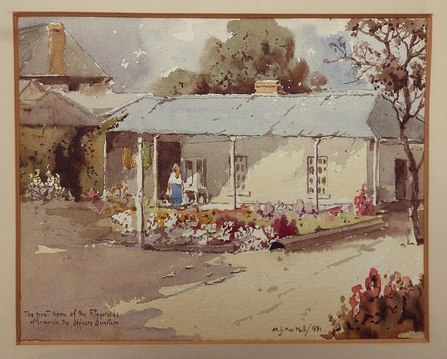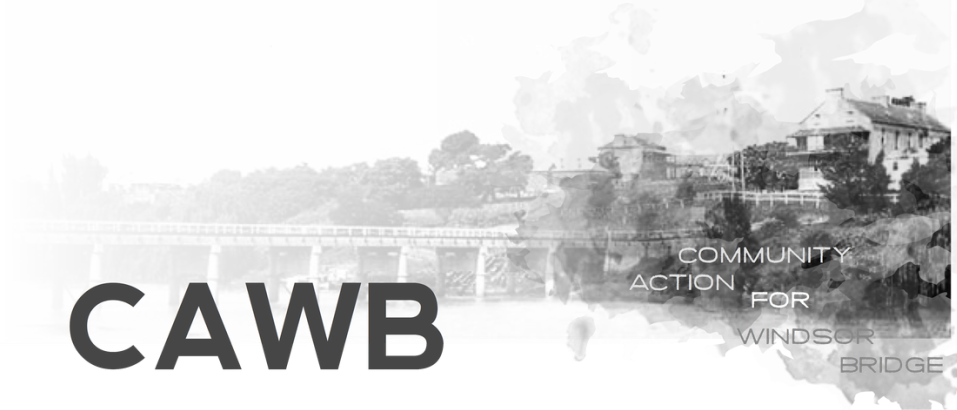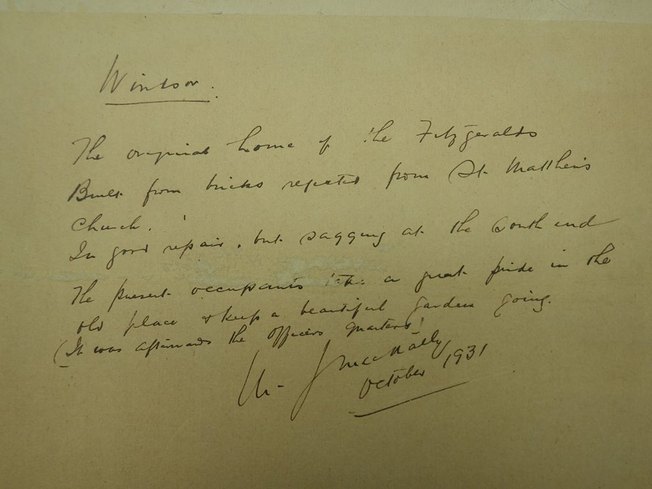
When this article was written by George Reeve in 1931, the home of Richard Fitzgerald still stood beside the Macquarie Arms (Royal Hotel). Sometime later, it disappeared to be replaced by the present two storey Fitzgerald House, a drive-through bottle shop and a car park. Does anyone know when this happened and the circumstances surrounding its loss? The writer has only found three images of this, one of the nation’s most significant dwellings – the watercolour by MacNally is one of these three images and appears to depict the cottage from the back, with the Royal ( Macquarie Arms) Hotel in the background on the left.
QUOTE
FITZGERALD COTTAGE
Situated on the North East corner of George Street and Baker Street and adjoining the Royal Hotel, Windsor.
This historic cottage was built as a family residence by Mr Richard Fitzgerald, the bricks used in its construction said to be rejects from those made for the building of St Matthew’s Church of England, Windsor.
It is a matter of history that when the walls of St Matthew’s had reached a certain height, Governor Macquarie condemned the same. The bricks forming the walls were then taken and used in the construction of Fitzgerald Cottage, consequently the old house dates from the year 1817.
Richard Fitzgerald came out to Sydney as a “Government Man” by the “William and Ann” which arrived on August 28, 1791. Richard Fitzgerald it would appear soon received his freedom for Commissioner Bigge in his report to the English Government of the year 1822, says -
“Mr Richard Fitzgerald who superintended the establishment at Emu Plains was formerly employed in the same capacity at those of Castle Hill and Toongabbie in the years 1792 and 1793. The further progress of this individual who was formerly a convict is detailed in his evidence. It is sufficient at present to remark that it was highly creditable to his industry and to his integrity and that he has since the arrival of Governor Macquarie, not only enjoyed his confidence and friendship but has held the situation of Storekeeper and Clerk in Charge in the Commissary’s Department at Windsor.........
In another part of Biggs’ famous report....Bigge says “Amongst the persons mentioned that have been admitted to the society of Government House by Gov. Macquarie was Richard Fitzgerald......the good conduct of Richard Fitzgerald as agent to John Macarthur during Macquarie’s absence from NSW has procured him an admission to the Society of his most respectable family, upon the same footing which a family agent would be admitted in England.”
From the extracts it can be seen that Mr Richard Fitzgerald was generally popular with those people who controlled the situation in the Colony.....and he secured many large pastoral land grants...in NSW, as did one of his sons, Robert Fitzgerald who was born in Windsor in 1807. Another son, Richard, was killed aged 17 years by accident, being thrown from his horse April 25, 1822. Another son, John, died April 20 1835 at 23 years.
The pioneer Fitzgerald’s name was given to one of Windsor’s main cross streets. Both Robert and Richard were benevolently disposed. The Hawkesbury Benevolent Society at Windsor, a splendid institution for aged folks owes its existence to Richard Fitzgerald. The Society was formed in the middle ‘20’s of last century through the efforts of Mrs Fitzgerald and John Howe, a free pioneer by the Coromandel (1802) aided and assisted by many other notable pioneers of the Hawkesbury. Mr Richard Fitzgerald who died aged 68 in 1840 made provision in his Will for the annual payment to the Hawkesbury Benevolent Society of 50 Pounds. Mary, Richard’s wife predeceased him:-
DIED – “On Tuesday 12th instant March 2 1833 after a protracted illness attended by much suffering, aged 53, Mary, Wife of Richard Fitzgerald Esq., an old and respectable inhabitant of the Hawkesbury. Mrs Fitzgerald has left a husband and two sons to deplore the loss of an affectionate and valuable wife and mother and numerous acquaintances to lament the death of a kind and hospitable friend – and, in fact, Windsor and its vicinity to mourn for a charitable member of society. Mrs Fitzgerald leaves behind her a character of benevolence which is worthy of imitation by her neighbours, the loss of which, if not inherited by someone who will forth on equally bountiful hands to the cry of distress must stamp with poignant regret the heart of many a poor survivor.”....................
Returning to the history of Fitzgerald’s Cottage at Windsor, during its long career it has been occupied by many well known Hawkesbury people. Mr James Bligh Johnston and his family resided there for many years.
Mr H. Hall, the first Australian born son of pioneer George Hall was married to Mr J. B. Johnston’s first sister, Hannah Hall and it was while the James H. Hall and Johnston families were present for the Christmas festivities at Fitzgerald Cottage that Mr James Hawkesbury Hall took ill and died there, 23rd Dec. 1874 “ much regretted by his wife, daughters relatives and friends.”
A note from the Sydney Gazette June 17 1830 in the form of a paragraph says – “Referring to the historic Fitzgerald Cottage Mr (Dr ) Clayton ( Jun.) has finally settled in the prosecution of his medical career at Windsor. He has taken that beautiful little box called Fitzgerald Cottage. The circle of practice he has marked out is very extensive comprising Richmond, Wilberforce, Pitt Town and the entire district of the Hawkesbury beyond the Nepean.”
George G. Reeves 1931
Mr MacNally wrote on the back of his watercolour -
“The original home of the Fitzgeralds. Built from bricks rejected from St Matthew’s Church.
In good repair., but sagging at the South end and the present occupants take a great pride in the old place and keep a beautiful garden going.
(It was .......? the Officers Quarters).
M. J. MacNally Oct. 1931
QUOTE
FITZGERALD COTTAGE
Situated on the North East corner of George Street and Baker Street and adjoining the Royal Hotel, Windsor.
This historic cottage was built as a family residence by Mr Richard Fitzgerald, the bricks used in its construction said to be rejects from those made for the building of St Matthew’s Church of England, Windsor.
It is a matter of history that when the walls of St Matthew’s had reached a certain height, Governor Macquarie condemned the same. The bricks forming the walls were then taken and used in the construction of Fitzgerald Cottage, consequently the old house dates from the year 1817.
Richard Fitzgerald came out to Sydney as a “Government Man” by the “William and Ann” which arrived on August 28, 1791. Richard Fitzgerald it would appear soon received his freedom for Commissioner Bigge in his report to the English Government of the year 1822, says -
“Mr Richard Fitzgerald who superintended the establishment at Emu Plains was formerly employed in the same capacity at those of Castle Hill and Toongabbie in the years 1792 and 1793. The further progress of this individual who was formerly a convict is detailed in his evidence. It is sufficient at present to remark that it was highly creditable to his industry and to his integrity and that he has since the arrival of Governor Macquarie, not only enjoyed his confidence and friendship but has held the situation of Storekeeper and Clerk in Charge in the Commissary’s Department at Windsor.........
In another part of Biggs’ famous report....Bigge says “Amongst the persons mentioned that have been admitted to the society of Government House by Gov. Macquarie was Richard Fitzgerald......the good conduct of Richard Fitzgerald as agent to John Macarthur during Macquarie’s absence from NSW has procured him an admission to the Society of his most respectable family, upon the same footing which a family agent would be admitted in England.”
From the extracts it can be seen that Mr Richard Fitzgerald was generally popular with those people who controlled the situation in the Colony.....and he secured many large pastoral land grants...in NSW, as did one of his sons, Robert Fitzgerald who was born in Windsor in 1807. Another son, Richard, was killed aged 17 years by accident, being thrown from his horse April 25, 1822. Another son, John, died April 20 1835 at 23 years.
The pioneer Fitzgerald’s name was given to one of Windsor’s main cross streets. Both Robert and Richard were benevolently disposed. The Hawkesbury Benevolent Society at Windsor, a splendid institution for aged folks owes its existence to Richard Fitzgerald. The Society was formed in the middle ‘20’s of last century through the efforts of Mrs Fitzgerald and John Howe, a free pioneer by the Coromandel (1802) aided and assisted by many other notable pioneers of the Hawkesbury. Mr Richard Fitzgerald who died aged 68 in 1840 made provision in his Will for the annual payment to the Hawkesbury Benevolent Society of 50 Pounds. Mary, Richard’s wife predeceased him:-
DIED – “On Tuesday 12th instant March 2 1833 after a protracted illness attended by much suffering, aged 53, Mary, Wife of Richard Fitzgerald Esq., an old and respectable inhabitant of the Hawkesbury. Mrs Fitzgerald has left a husband and two sons to deplore the loss of an affectionate and valuable wife and mother and numerous acquaintances to lament the death of a kind and hospitable friend – and, in fact, Windsor and its vicinity to mourn for a charitable member of society. Mrs Fitzgerald leaves behind her a character of benevolence which is worthy of imitation by her neighbours, the loss of which, if not inherited by someone who will forth on equally bountiful hands to the cry of distress must stamp with poignant regret the heart of many a poor survivor.”....................
Returning to the history of Fitzgerald’s Cottage at Windsor, during its long career it has been occupied by many well known Hawkesbury people. Mr James Bligh Johnston and his family resided there for many years.
Mr H. Hall, the first Australian born son of pioneer George Hall was married to Mr J. B. Johnston’s first sister, Hannah Hall and it was while the James H. Hall and Johnston families were present for the Christmas festivities at Fitzgerald Cottage that Mr James Hawkesbury Hall took ill and died there, 23rd Dec. 1874 “ much regretted by his wife, daughters relatives and friends.”
A note from the Sydney Gazette June 17 1830 in the form of a paragraph says – “Referring to the historic Fitzgerald Cottage Mr (Dr ) Clayton ( Jun.) has finally settled in the prosecution of his medical career at Windsor. He has taken that beautiful little box called Fitzgerald Cottage. The circle of practice he has marked out is very extensive comprising Richmond, Wilberforce, Pitt Town and the entire district of the Hawkesbury beyond the Nepean.”
George G. Reeves 1931
Mr MacNally wrote on the back of his watercolour -
“The original home of the Fitzgeralds. Built from bricks rejected from St Matthew’s Church.
In good repair., but sagging at the South end and the present occupants take a great pride in the old place and keep a beautiful garden going.
(It was .......? the Officers Quarters).
M. J. MacNally Oct. 1931



